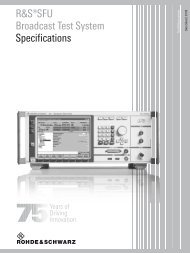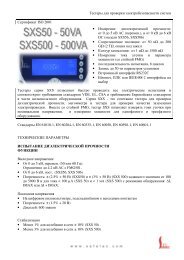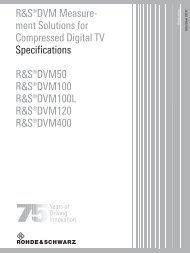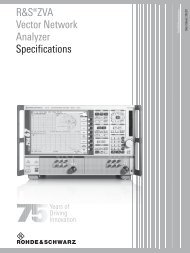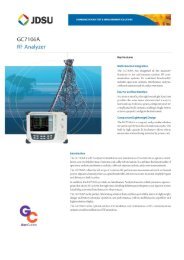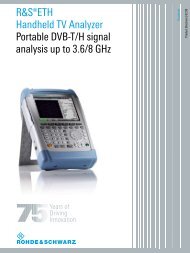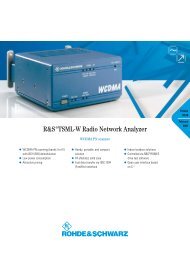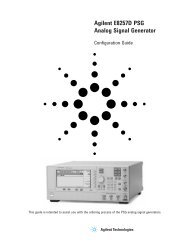Dual-Channel Analyzer/Power Supply NGMO2
Dual-Channel Analyzer/Power Supply NGMO2
Dual-Channel Analyzer/Power Supply NGMO2
You also want an ePaper? Increase the reach of your titles
YUMPU automatically turns print PDFs into web optimized ePapers that Google loves.
<strong>Dual</strong>-<strong>Channel</strong> <strong>Analyzer</strong>/<strong>Power</strong> <strong>Supply</strong> <strong>NGMO2</strong>Precise power supply and measurements under critical test conditions◆ Two channels 15 V/2.5(5) A with7 A peak◆ Fast load regulation◆ Result memory for fast current andvoltage measurements◆ Internal and external triggers◆ Two separate voltage measurementchannels◆ Sinking to 2.8 A (static)◆ High-resolution voltage settings◆ Precise measurements in µA range◆ Minimal ripple and noise◆ Adjustable output impedance forbattery emulation◆ OVP/OCP◆ Detection of open sense pins◆ Auxiliary inputs/outputs (output inhibit,relay, complete, trigger)◆ Compact design (2 HU, ½ 19“)◆ IEEE488.2, RS-232-Cinterfaces◆ Fast programming◆ Convenient manual operation
<strong>Dual</strong>-<strong>Channel</strong> <strong>Analyzer</strong>/<strong>Power</strong> <strong>Supply</strong> <strong>NGMO2</strong> ...The <strong>Dual</strong>-<strong>Channel</strong> <strong>Analyzer</strong>/<strong>Power</strong> <strong>Supply</strong><strong>NGMO2</strong> from Rohde & Schwarz is morethan just a simple power supply for testand measurement applications. This isshown by its advanced features:◆ accurate high-speed voltage source,◆ programmable DC load,◆ precise digital voltmeter,◆ storage oscilloscope,◆ simple squarewave generatordelivering high output power,and two of each of these features are provided.Two independent channels,installed in an enclosure which is ½ 19“wide and only 2 U high, guarantee a simpleand accurate power supply for battery-operatedmobile-radio products nowand in the future.Numerous analysis functions extend thefunctionality of conventional power supplies.And, it is not just development engineerswho will value this instrument. Inproduction environments in particulartwo things are important: speed and reliability.The <strong>NGMO2</strong> has both, coupledwith high accuracy which is essential ifresults are to be reproducible.2 <strong>Dual</strong>-<strong>Channel</strong> <strong>Analyzer</strong>/<strong>Power</strong> <strong>Supply</strong> <strong>NGMO2</strong>
InterfacesThe <strong>NGMO2</strong> can be remote-controlled viathe three main, standard interfaces IEC/IEEE bus, RS-232-C and USB. It has anumber of additional I/O channels thatcan be used to good effect when everyextra operation performed by a PC or aninternal microcontroller could cause anoverload or simply lead to unwanteddelays. Each channel has a fast outputinhibit to rapidly turn a preset voltage onor off. This may be necessary to test, forexample, power semiconductors to preventdestruction by overheating. Not onlycan the integral, fast current-transientrecorder be triggered by internal triggerthresholds for the output current, it alsohas an external trigger input so that synchronizationcan be effected using externaltrigger signals. Although the digitalsignal processor in the <strong>NGMO2</strong> is fastenough to ensure minimal setting andread times for IEC/IEEE-bus programming,the last microsecond delay can beeliminated by directly providing a completeoutput signal.... since high tech starts at the sourceRelay (Sub-D-15)Output<strong>NGMO2</strong> rear viewPin Function1 RELOUT12 RELOUT23 RELOUT34 RELOUT45 FAULT6 NC7 NCPin Function8 GND9 GND10 INHIBIT_B11 TRIGGER_B12 INHIBIT_A13 TRIGGER_A14 COMPL_B15 COMPL_APin Function1 DVM−2 DVM+3 FORCE−4 FORCE−5 SENSE−6 SENSE+7 FORCE+8 FORCE+<strong>Dual</strong>-<strong>Channel</strong> <strong>Analyzer</strong>/<strong>Power</strong> <strong>Supply</strong> <strong>NGMO2</strong> 3
POWERCHN 1A/B/DVMOUTP 6ON/OFFSHIFTENTERVARIATIONSourceR iSourceConnecting a mobile phone to <strong>NGMO2</strong> via separate twisted pairs and equivalent circuit diagram (below)+V Source–POWER SUPPLY · <strong>NGMO2</strong>U-SET 2 OVP 3 OVP 3 MENUE 5I-SET 7 OCP 8 OCP 8 LOCAL 0+Force+Sense–Sense–ForceCritical test environments involving pulsed current drain,e.g. GSM mobile phones<strong>Power</strong>-saving transmission technologieshave been, and will continue to be, thekey to expanding the capabilities ofmobile radio. These improvements are achallenge to both test engineers and testequipment. This is particularly true oftransmission technologies that make useof time division multiplexing, for exampleGSM or TDMA, and also applies to the“slotted mode” used for CDMA – in bothcases power supplies have to meet specialrequirements. On production lines,the use of switching matrices, adapters02R LL LForceSenseDUTR L L LC pDUT R iDUT (t)and leads means that cables up to sixmeters in length can be found betweenthe power supply and the actual DUT.Cable flexibility must be adequate, whichmeans that the force-line cross sectioncannot be as large as it should be. Andthen there are the rise and fall timescaused by mobile phones taking theirpower in pulses: these times can be tensof µs. The inductance of the conductorsin the cables causes significant voltagedrops. The power supply must, therefore,be capable of compensating for any voltagedrops across the terminals of themobile phone’s battery. Compensationhas to be performed extremely rapidly tobe effective. If not, the undervoltagedetector in the mobile will simply turn thephone off. <strong>NGMO2</strong> can meet the challengesdescribed above without any hintof output voltage instability.Emulation of various batterytypes and charging statesMobile, electronic communication equipmentis usually battery-operated. If powersupply units are used to replace batteriesduring production, highly satisfactoryresults are obtained with power supplieswith optimized regulation. There is, however,one drawback with this approach:as a power supply’s internal resistance isusually fixed, it is an ideal case that isbeing simulated, i.e. that of a fullycharged battery. As a battery discharges,its internal resistance continuouslyincreases. This means that the voltageacross the DUT drops. To maintain itstransmit power, a GSM mobile phone, forexample, increases its current drainwhich in turn produces an even greatervoltage drop along the power leads andacross the battery’s internal resistancewhich is already very high. This can leadto a vicious circle. The internal supplyvoltage conditioning of the circuit underLoad regulation of non-optimal lab power supply connected to critical GSMmobile phoneLoad regulation of <strong>NGMO2</strong> connected to critical GSM mobile phone4 <strong>Dual</strong>-<strong>Channel</strong> <strong>Analyzer</strong>/<strong>Power</strong> <strong>Supply</strong> <strong>NGMO2</strong>
ADSpeechencoderBurstbuilderTXPLL synthesizerwith VCOPARingerADPCMµControllerLCDKeypadADSpeechdecoderBurstdecoderRXDemodulatorMixerLNAPAonTXonTXLoffRXSWon417 µsTransmit365 µs0 1 2 3 4 5 6 7 8 9I TXLOFF I CPUI PAONtest must be capable of reliably handlingvoltage drops of this kind without causingthe phone to malfunction. The <strong>NGMO2</strong>can be used to emulate this critical caseas its output impedance is adjustable.This also means that different types ofbatteries (NiCd, NiMH, Li-ion, Li-polymeretc) can be emulated to a certain extent.This guarantees that nothing can happento invalidate tests despite the generaltrend to lower supply voltages.10 ms TDMA frame = 24 timeslotsCurrent drain of DECT mobile telephone, measured with high time resolutionReceive10 11 12 13 14 15 16 17 18 19 20 21 22 23I RXCurrent-/voltage transientanalysisThe integral current-transient recorder isa very useful tool for analyzing DUT faults.For example, conclusions can be drawnabout whether or not the subassembliesto be tested are functioning properly byforming the differences of the measuredcurrent drain of a sequence of signalsoccurring in rapid succession. For example,a DECT mobile telephone: in thiscase, the current-drain curve over a completeframe can be recorded using a veryhigh time resolution. When the telephonemanufacturer knows at which points intime certain subassemblies (completephone, power amplifier, mixer, receiver,display etc) are activated or deactivated,defective partial clusters can easily befound without using additional, complextest equipment.The reproducibility of pulse current measurementscan be improved even furtherby not just reading one frame and analyzingit, but instead pin-pointing a specificsection of interest and reading it. Thismeasurement is repeated several times insuccession and the average taken. Thesection to be investigated is determinedby means of the programmable samplingrate and the number of samples. The triggerpoint for the transient recorder can bedefined with an adjustable current triggerthreshold. This means that only relevantinformation is saved to the sample memory.By limiting the number of samples, itis also possible to optimize the transferrate when samples are being read. It goeswithout saying that long-term monitoring(current drain) can also be performed onDUTs by choosing sampling intervals ofthe appropriate length so that the effectof other operating parameters on currentdrain can be investigated.<strong>Dual</strong>-<strong>Channel</strong> <strong>Analyzer</strong>/<strong>Power</strong> <strong>Supply</strong> <strong>NGMO2</strong> 5
However, power consumption is alsobecoming more and more critical for subassemblieswhich are not battery-operated.Operating modes such as idle, sleepor power down are being encounteredmore frequently in electronic equipmentbecause higher clock frequencies coupledwith an increasing level of integrationare making it impossible to ignoreefficient energy management. Using ahigh-resolution current-transientrecorder, like the one already installed inthe <strong>NGMO2</strong>, these modes can bechecked using methods similar to thosedescribed above.In addition to current transients, the<strong>NGMO2</strong> is able to record voltage transients.High-resolution current measurementsand voltage settingsACurrent levelPeak currentHigh currentLow currentStandby currentmAOff currentµARange of current drain levels for various GSM mobile phone operating modesA2TimeAs the Fig. on the right shows, there areextremely wide variations in the currenttaken by mobile telephone operatingmodes. Current peaks of up to 2 A takenat maximum transmit power contrastwith currents of a few µA in the OFFstate. In between is the normal modewhere currents are the order of a few100 mA. It is essential to have enoughresolution to detect deviations from thenormal mobile mode whenever theymight occur. The <strong>NGMO2</strong>, therefore, hasdifferent current measurement ranges forboth static and dynamic current measurements.The <strong>NGMO2</strong> also has the necessaryvoltage setting resolution of 1 mV tocalibrate and adjust DUTs and to providereproducible voltage levels. This aspectwill gain in significance as the trend istowards lower supply voltages.Recording characteristics ofsemiconductor componentsThe <strong>NGMO2</strong> has two completely identicalsupply and measurement channels. This0Dynamic current drain of critical GSM mobile phone, measured with <strong>NGMO2</strong>means that this small power supply unitcan be used to form the basis of an independentparameter test setup for semiconductorcomponents. The <strong>NGMO2</strong> canalso handle up to four relays and respondto remote control commands. As eachchannel has an inhibit input, if required, apulsed supply voltage can be fed to thecomponents to prevent overheating duringtests or to simulate a standard pulsedoperating mode (e.g. TDMA power amplifier).6 <strong>Dual</strong>-<strong>Channel</strong> <strong>Analyzer</strong>/<strong>Power</strong> <strong>Supply</strong> <strong>NGMO2</strong>
SpecificationsConstant voltage source <strong>Channel</strong>s 1 + 2(both channels with identical specs)Voltage setting0 to 15 VResolution1 mVDeviation0.05% + 5 mVat ±10% AC supply fluctuation 0.5 mVat 10 to 90% nom. current 2.5 mVSettling time on load steps(0.1 A to 1.6 A) at ≤20 mVDeviationat large bandwidthdirectly connected
PD 757.6579.21 ⋅ <strong>Dual</strong>-<strong>Channel</strong> <strong>Analyzer</strong>/<strong>Power</strong> <strong>Supply</strong> <strong>NGMO2</strong> ⋅ Trade names are trademarks of the owners ⋅ Subject to change ⋅ Data without tolerances: typical valuesPrinted in Germany 0301 (Bi we)ROHDE&SCHWARZ GmbH & Co. KG ⋅ Mühldorfstraße 15 ⋅ 81671 München ⋅ Germany ⋅ P.O.B. 8014 69 ⋅ 81614 München ⋅ GermanyTelephone +49894129-0 ⋅ www.rohde-schwarz.com ⋅ CustomerSupport: Tel. +491805124242, Fax +4989 4129-13777, E-mail: CustomerSupport@rohde-schwarz.com




